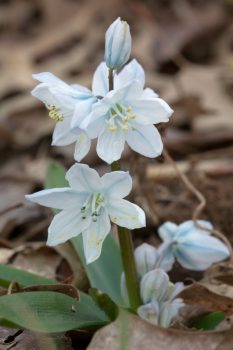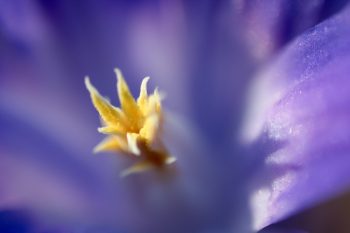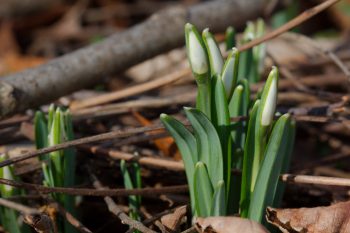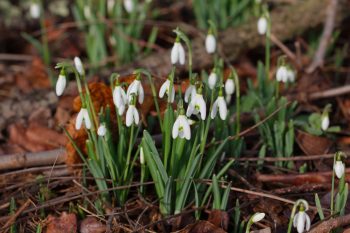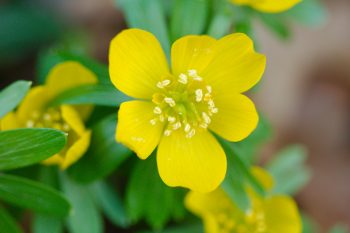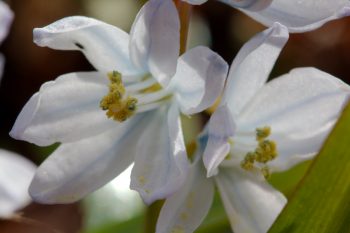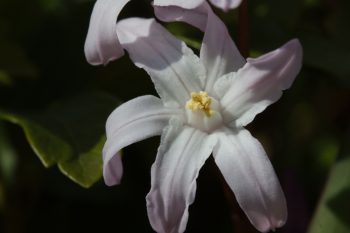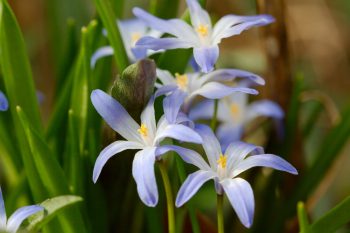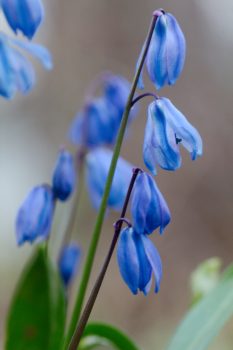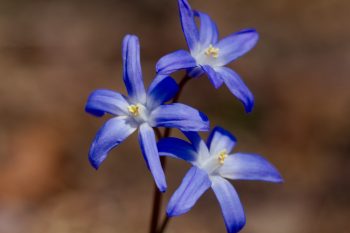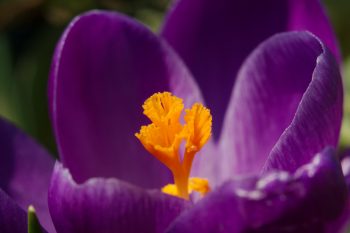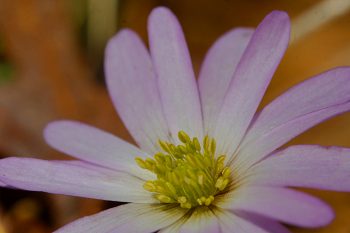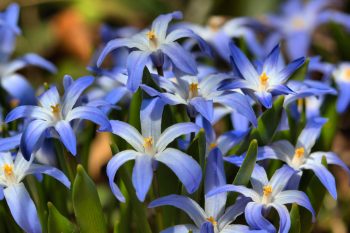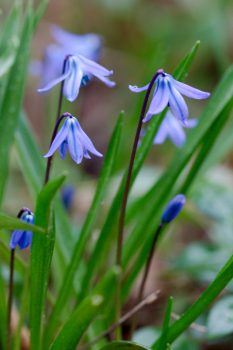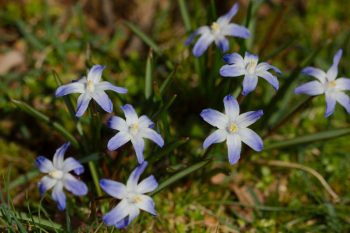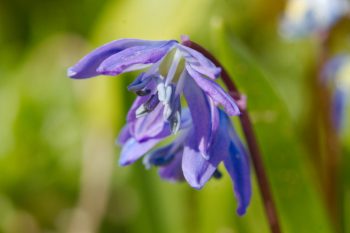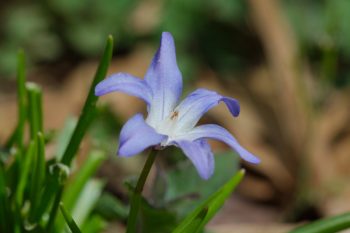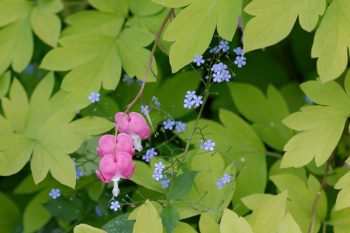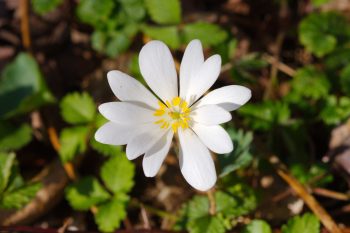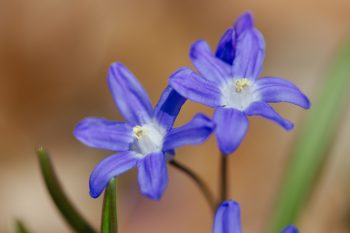The white crocuses and this white squill started blooming yesterday. The binomial is Scilla mischtschenkoana which has to be in the running for the word with the most consecutive consonants. Anyway, it’s a pretty little thing. Some daffodils started blooming today, but I can only post one picture here, so you’ll have to wait. I have a feeling you’ll be getting sick of my flower pictures before too long.
Tagged With: Spring Ephemerals
The First Scilla
Chionodoxa lucilae
I thought I’d try some extreme close-up shots today. I can’t say they are award winning pictures but after all, the challenge was to post a picture a day, not to win any awards. Anyway, Chionodoxa, or glory-of-the-snow, is one of my favorite flowers.
Snow Drops (Galanthus nivalis)
After taking the picture of the sparrow (see previous post) I headed back toward my van to get the rest of my things and go into the office. As I walked along the edge of the woods, it occurred to me that the snow drops (Galanthus nivalis) would be coming up soon, if they have not started already. I looked and sure enough, they are well on their way to blooming. It isn’t spring yet, but it’s coming and I know there are a lot of folks who are ready for warmer weather. I love the early spring ephemerals and this is one of the earliest.
Snow Drops (Galanthus nivalis)
Just under two weeks ago (see Thursday, February 08, 2018) I posted a picture of the snow drops (Galanthus nivalis) coming up at the edge of the woods around my office building. Now they are pretty much up, even if there haven’t quite reached their peak. When I got to work this morning I figured I’d spend a few minutes with them before heading inside. This time, when I got down on the ground to take the pictures, I thought ahead and got a blanket out of the car to lie on. Last time I got a bit spot of dirt on my shirt and more on my jeans. Today I managed to stay clean. Spring is just around the corner. Not saying we won’t have more snow. That can happen well into March or even occasionally April. But spring is definitely coming.
Eranthis hyemalis
As mentioned in yesterday’s post, the winter aconite (Eranthis hyemalis) is blooming here. I only have two small plants but the seem to be growing a small amount each year. Mom has a nice, dense patch of them near the foot of the driveway and I love seeing them at this time of the year. They are in the family Ranunculaceae (the buttercup family) and are very reliable, very long lived little plnts. They are, I’m afraid, fairly slow to get established and I haven’t had huge success with them. Still, thase that did make it are here for the long haul.
Scilla mischtschenkoana
This is one of my favorite little, spring bulbs. I don’t think I could ever have too many Scilla and Chionodoxa bulbs in my yard. I currently have two species of each. This is the less common of the two Scilla, with the other being the much bluer Scilla siberica. The flowers of the Chionodoxa species are similar but are more upward facing. One of those is pink and the other a really beautiful blue. These are mostly white with just a small amount of blue down the middle of each petal.
Chionodoxa forbesii ‘Pink Giant’
The Chionodoxa forbesii ‘Pink Giant’ has begun to bloom in the shady northern corner of our yard. It’s more shady later in the year, when the oak that is over it has leaves. This time of year it gets a fair amount of sun from mid morning through early afternoon. This is a pretty little plant, barely showing itself over the Pachysandra terminalis (Japanese pachysandra). There are some others coming up, as well. And our early, small daffodils are in bloom. In spite of the snow we had last week, it’s really starting to look, if not to feel, like spring.
Chionodoxa forbesii
I’ve planted a fair amount of this around the yard but I’m not sure I could ever have too much of it. Chionodoxa forbesii, commonly called glory of the snow, is a beautiful, little early spring bulb. Although the daffodils have started blooming and they overlap with this, these are going to be done well before the daffodils. The Latin genus, Chionodoxa, comes from the Greek words chion meaning snow and doxa meaning glory. This reflects their very early flowering, often when snow is still on the ground. The specific epithet, forbesii, honors James Forbes (1773-1861), the British botanist who was employed as the gardener for the Duke of Bedford at Woburn Abbey.
Scilla siberica
I love this beautiful, little bulb. Along with the similar (and related) Chionodoxa (glory of the snow) species, it’s an early, generally blue-flowered bulb. It’s also a very welcome sign of spring. Not as early as the Eranthis or the Galanthus (snow drops, both of which start blooming here in February, it’s still a great thing to see coming up, especially when you have a late snow, as we did this year. Scilla siberica, commonly called Siberian squill, is native to Southern Russia and is hardy as far north as USDA Zone 2. Like Chionodoxa, it has small, mostly blue flowers but they are generally much more thoroughly blue. The other obvious difference is that they open facing downward while Chionodoxa flowers generally face up. If you don’t have any in your yard, I highly recommend them. Buy a bunch this fall and get them in the ground. You’ll be enjoying them for years to come.
Chionodoxa forbesii
After church we walked over to the Stadtman Preserve, where hundreds of daffodils are coming up and a few blooming. There were also huge drifts of winter aconite (Eranthis hyemalis) although they were almost entirely past their bloom. There were also a very few of these Chionodoxa forbesii flowers. With the common name glory of the snow, it’s no surprise that they bloom early and they are definitely one of my favorite flowers, especially among the spring ephemerals. It is native to western Turkey and is hardy as far north as USDA zone 3. Those growing in my garden are considerably behind, but I’m looking forward to having them bloom in a few weeks.
Crocus
The so-called Dutch crocus (Crocus vernus and its cultivars) is native to the mountains of Europe, the Pyrenees, Alps and Carpathians. The name crocus comes from krokos (κρόκος) the ancient Greek name for saffron (Crocus sativus). While crocuses prefer gritty, well-drained soils they do amazingly well in our heavy, clay soil that is totally water logged all winter most years. This one is growing in a bed of lily of the valley (Convallaria majalis) and Vinca minor in our back yard. There are also some daffodils and hyacinths that are starting to come up bu those won’t be in bloom for a little while yet.
Windflower (Anemone blanda)
Last Sunday after church we walked to the Stadtman Preserve and I posted a picture of three little Chionodoxa forbesii blossoms. This week we went there again. The daffodils are starting to bloom and there are lots more Chionodoxa flowers opening up throughout the property. It was this little windflower (Anemone blanda) that really caught my eye. It’s such a pretty little thing. I’ve had a few of them in our garden but they never really amounted to much. I need to make a note to myself to buy a bunch of them and put them in. Interestingly, the flower is apetalous (it has no petals) and what look like petals are actually sepals.
Chionodoxa forbesii
I try not to repeat subject too often and too close together but sometimes I just have to. The Sunday before last I posted a pictures of three Chionodoxa forbesii (glory of the snow) blossoms, taken at the Stadtman Preserve on Mill Run, in Derwood (see Sunday, March 17, 2019). Two weeks later they are out in our garden and I couldn’t resist another picture. This little clump of flowers is at the south end of our house and it’s so lovely. I promise, I’m done with this flower for the year (although there’s a pink variety in another part of our garden).
Scilla siberica
These little flowers, Scilla siberica (Siberian squill) are similar to the blue Chionodoxa forbesii (glory of the snow) that I photographed a few days ago but can be differentiated by their downward facing appearance. They are also deeper blue, in general. In my yard they bloom just a little later, but not much. These are in a bed right by the driveway so I get to see them every time I leave or get home, which is nice. S. siberica is native to southern Russia and is hardy up to USDA Zone 2.
I also have some Scilla mischtschenkoana, (commonly called simply squill) the flowers of which are almost white with just a hint of blue. They are native to northern Iran and the Caucasus and not quite as hardy as S. siberica but still plenty hardy for us here. I really should mark where all my spring ephemerals are and plant more around them this fall. I’m not sure I could ever have too many of them.
Chionodoxa forbesii
I think this is my absolute favorite of the spring ephemerals. It’s called glory of the snow in honor of it’s generally very early blooming time, sometimes when there is still snow on the ground. The genus Chionodoxa comes from the Greek words chion meaning snow and doxa meaning glory. I think it’s the color that I like best about it, along with its dainty habit and it’s remarkably easy care. It is hardy as far north as USDA zone 3. In a few short weeks it will be done and gone for the year, sleeping away both the heat of summer and the cold of next winter.
Scilla siberica
Blooming shortly after the beautiful, blue Chionodoxa forbesii (glory of the snow), the Scilla siberica (Siberian squill) are starting to come out. They are a darker blue with down-turned flowers but quite similar. In fact, “some experts have merged Chionodoxa into the genus Scilla under the belief that the differences are not significant enough to warrant separate genus status.” (Missouri Botanical Garden, Plant Finder). I don’t really care one way or the other and just enjoy them both as spring ephemerals. I look forward to their bloom every year and don’t think I could have too many of either.
Chionodoxa forbesii
It’s been more than a couple years since I planted any new bulbs but of course, one of the beauties of bulbs is that they come up pretty reliably every year. Tulips aren’t that long lived, but daffodils and some of the smaller, more ephemeral blooms will likely be coming up long after I’m gone. This is one of my very favorite blooms, Chionodoxa forbesii, also known as glory of the snow. I like the fact that it blooms so early but I think my favorite thing about it is the amazing blue color. I really need to plant more of this.
Bleeding Heart and Siberian Bugloss
After going to Fehr’s Nursery in Burtonsville, we stopped for lunch as a Cuban place on the way home. We could have picked a better day for it, as it was jammed for Mothers Day and it took us over an hour to get sandwiches. We’ll probably give them another try on a less busy day, but it was a bit off-putting. We drove to Woodlawn Manor and ate our sandwiches in the shade of one of their lovely trees. Then we walked around and I took a few photos, including a couple of the bleeding heart (Lamprocapnos spectabilis) and Siberian bugloss (Brunnera macrophylla, similar to forget-me-not) growing together under an America holly (Ilex opaca). Quite pretty, don’t you think?
Sanguinaria canadensis (Bloodroot)
We went for a walk near Rock Creek today and enjoyed the spring flowers. The spring beauties (Claytonia virginica) which are in great profusion. We also saw a few bloodroot (Sanguinaria canadensis) as seen here. The flower petals are the purest white with bright yellow stamens. Although they don’t last long, they are quite lovely for the little time they are blooming each spring. The roots have a red sap, which is where they get both their common name and their genus name. The leaves are palmate and deeply-scalloped and attractive in their own right.
Chionodoxa Species (Glory Of The Snow)
We went to the Agricultural History Farm Park briefly today. There are bulbs coming up and some Lenten rose in bloom. The photo I’m posting is of a spring ephemeral commonly called Glory of the Snow. The genus name, Chionodoxa, comes from the Greek words chion meaning snow and doxa meaning glory. It’s definitely one of my favorites and I have a fair number of these around the garden at home, including C. forbesii and C. luciliae (which I think this probably is, but I’m not sure).

